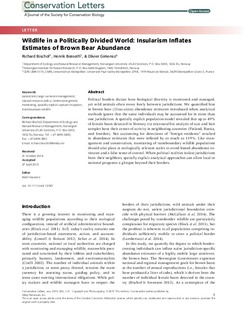| dc.contributor.author | Bischof, Richard | |
| dc.contributor.author | Brøseth, Henrik | |
| dc.contributor.author | Gimenez, Olivier | |
| dc.date.accessioned | 2015-11-06T09:59:32Z | |
| dc.date.accessioned | 2015-11-06T11:34:23Z | |
| dc.date.available | 2015-11-06T09:59:32Z | |
| dc.date.available | 2015-11-06T11:34:23Z | |
| dc.date.issued | 2015 | |
| dc.identifier.citation | Conservation Letters 2015 | nb_NO |
| dc.identifier.issn | 1755-263X | |
| dc.identifier.uri | http://hdl.handle.net/11250/2359567 | |
| dc.description.abstract | Political borders dictate how biological diversity is monitored and managed,
yet wild animals often move freely between jurisdictions. We quantified bias
in brown bear (Ursus arctos) abundance estimates introduced when analytical
methods ignore that the same individuals may be accounted for in more than
one jurisdiction. A spatially explicit population model revealed that up to 49%
of female bears detected in Norway via microsatellite analysis of scat and hair
samples have their center of activity in neighboring countries (Finland, Russia,
and Sweden). Not accounting for detections of “foreign residents” resulted
in abundance estimates that were inflated by as much as 119%. Like man-
agement and conservation, monitoring of transboundary wildlife populations
should take place at ecologically relevant scales to avoid biased abundance es-
timates and a false sense of control. When political realities isolate jurisdictions
from their neighbors, spatially explicit analytical approaches can allow local or
national programs a glimpse beyond their borders.
Jurisdiction; large carnivore management;
natural resource policy; noninvasive genetic
monitoring; spatially explicit capture-recapture;
transboundary wildlife. | nb_NO |
| dc.language.iso | eng | nb_NO |
| dc.rights | Navngivelse-Ikkekommersiell 3.0 Norge | * |
| dc.rights.uri | http://creativecommons.org/licenses/by-nc/3.0/no/ | * |
| dc.subject | Jurisdiction | nb_NO |
| dc.subject | large carnivore management | nb_NO |
| dc.subject | natural resource policy | nb_NO |
| dc.subject | spatially explicit capture-recapture | nb_NO |
| dc.subject | transboundary wildlife | nb_NO |
| dc.subject | noninvasive genetic monitoring | nb_NO |
| dc.title | Wildlife in a Politically Divided World: Insularism Inflates Estimates of Brown Bear Abundance | nb_NO |
| dc.type | Peer reviewed | nb_NO |
| dc.type | Journal article | |
| dc.date.updated | 2015-11-06T09:59:32Z | |
| dc.subject.nsi | VDP::Mathematics and natural science: 400::Zoology and botany: 480 | nb_NO |
| dc.source.journal | Conservation Letters | nb_NO |
| dc.identifier.doi | 10.1111/conl.12183 | |
| dc.identifier.cristin | 1266975 | |
| dc.relation.project | Norges forskningsråd: 204202 | nb_NO |

